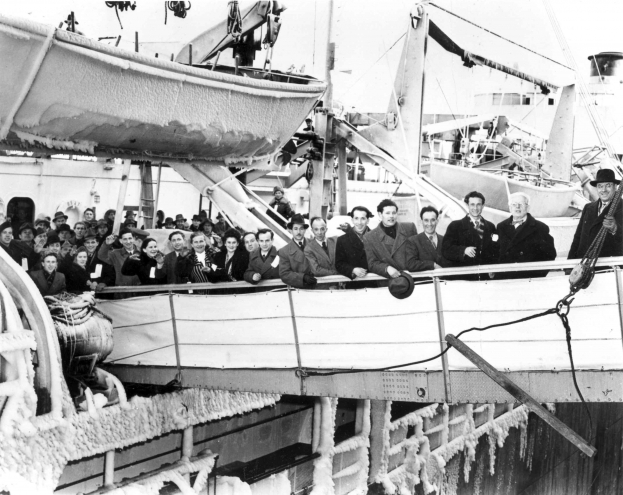Browse "Religion"
-
Article
Jesuits' Estates Act
During the French regime Jesuits were granted considerable property and seigneuries, which they used for educational purposes and for their missions among Indigenous people.
"https://development.thecanadianencyclopedia.ca/images/tce_placeholder.jpg?v=e9dca980c9bdb3aa11e832e7ea94f5d9" // resources/views/front/categories/view.blade.php
https://development.thecanadianencyclopedia.ca/images/tce_placeholder.jpg?v=e9dca980c9bdb3aa11e832e7ea94f5d9
-
Article
Jewish Canadians
Unlike most immigrants to Canada, Jews did not come from a place where they were the majority cultural group. Jews were internationally dispersed at the time of the ancient Roman Empire and after unsuccessful revolts against it lost their sovereignty in their ancient homeland. Subsequently, Jews lived, sometimes for many centuries, as minorities in the Middle East, North Africa and Europe. Jews have been in what would become Canada as early as the 18th century. Many more immigrated in the 19th and 20th centuries. In the 2021 census, around 335,000 people identified themselves as Jewish in Canada. (See also Judaism.)
"https://d2ttikhf7xbzbs.cloudfront.net/media/media/455197f8-b830-4e6f-8952-4bbaa53ee57d.jpg" // resources/views/front/categories/view.blade.php
https://d2ttikhf7xbzbs.cloudfront.net/media/media/455197f8-b830-4e6f-8952-4bbaa53ee57d.jpg
-
Article
Judaism
Judaism is the religion of the Jewish people. Its origins were in ancient Israel, where the sacred text of the Hebrew Bible was understood to be God's revelation. The Bible's core is the Torah-the 5 books delivered by God to the Jewish people at Mount Sinai through their liberator, teacher and prophet Moses. The other sections of the Bible- the books of the prophets, histories and ethical works-are based on the centrality of the Torah.
"https://d2ttikhf7xbzbs.cloudfront.net/media/media/7415bf5c-1da1-4b50-8e62-350189a3e243.jpg" // resources/views/front/categories/view.blade.php
https://d2ttikhf7xbzbs.cloudfront.net/media/media/7415bf5c-1da1-4b50-8e62-350189a3e243.jpg
-
Article
Kwanzaa
Kwanzaa is an African American cultural holiday that has been adopted around the world, including in Canada, to celebrate African family, community and culture.
"https://d2ttikhf7xbzbs.cloudfront.net/media/media/e1909fb3-4c4e-4f77-bbc7-81cdccc0e368.jpg" // resources/views/front/categories/view.blade.php
https://d2ttikhf7xbzbs.cloudfront.net/media/media/e1909fb3-4c4e-4f77-bbc7-81cdccc0e368.jpg
-
Article
L' Action française
Action française, L' , a monthly magazine published 1917-28 in Montréal. It was the voice of a group of priests and nationalists who comprised the Ligue des droits du français, an organization formed in
"https://d2ttikhf7xbzbs.cloudfront.net/media/media/6e559a82-fa39-4e67-8505-cd188e83d9d0.jpg" // resources/views/front/categories/view.blade.php
https://d2ttikhf7xbzbs.cloudfront.net/media/media/6e559a82-fa39-4e67-8505-cd188e83d9d0.jpg
-
Article
L' Action nationale
L'Action nationale was founded in 1933 by economist Esdras Minville as the voice of the Ligue d'Action nationale. It is the oldest journal of intellectual opinion writing in Quebec.
"https://d2ttikhf7xbzbs.cloudfront.net/media/media/6e559a82-fa39-4e67-8505-cd188e83d9d0.jpg" // resources/views/front/categories/view.blade.php
https://d2ttikhf7xbzbs.cloudfront.net/media/media/6e559a82-fa39-4e67-8505-cd188e83d9d0.jpg
-
Article
L'Arche
L’Arche is a not-for-profit social service agency that creates and runs supportive communities for people with intellectual disabilities. Founded in 1964, L’Arche builds communities where people with and without intellectual disabilities work, play, live and learn together. L’Arche Canada is part of the International Federation of L’Arche Communities. L’Arche International operates 153 communities worldwide in 38 countries. The organization has over 10,000 members with and without intellectual disabilities worldwide. In Canada, L’Arche operates 31 communities in nine provinces as of 2020.
"https://d2ttikhf7xbzbs.cloudfront.net/media/new_article_images/L'Arche_screenshot.png" // resources/views/front/categories/view.blade.php
https://d2ttikhf7xbzbs.cloudfront.net/media/new_article_images/L'Arche_screenshot.png
-
Article
Le Graduel romain
Le Graduel romain. A collection containing all the chants for the Proper of the mass: introit, gradual, tract or alleluia, offertory, and communion, as well as those for the Feasts of Our Lord (the Proper of the Time) and of the Saints (the Common of the Saints).
"https://development.thecanadianencyclopedia.ca/images/tce_placeholder.jpg?v=e9dca980c9bdb3aa11e832e7ea94f5d9" // resources/views/front/categories/view.blade.php
https://development.thecanadianencyclopedia.ca/images/tce_placeholder.jpg?v=e9dca980c9bdb3aa11e832e7ea94f5d9
-
Article
Manitou
An Algonquian word meaning "mysterious being," or simply "mystery," that represents the unknown power of life and the universe.
"https://development.thecanadianencyclopedia.ca/images/tce_placeholder.jpg?v=e9dca980c9bdb3aa11e832e7ea94f5d9" // resources/views/front/categories/view.blade.php
https://development.thecanadianencyclopedia.ca/images/tce_placeholder.jpg?v=e9dca980c9bdb3aa11e832e7ea94f5d9
-
Article
Methodism
The movement was first represented in what is now Canada by one of Wesley's followers, Laurence COUGHLAN, who began to preach in Newfoundland in 1766. Yorkshire settlers around Chignecto, NS, in the 1770s were the first sizable group of Methodists in the Maritimes.
"https://d2ttikhf7xbzbs.cloudfront.net/media/media/15c7fc4e-83d2-495c-a288-da377bb62d06.jpg" // resources/views/front/categories/view.blade.php
https://d2ttikhf7xbzbs.cloudfront.net/media/media/15c7fc4e-83d2-495c-a288-da377bb62d06.jpg
-
Article
Metropolitan Methodist Church
Metropolitan Methodist Church, now called Metropolitan United Church, is located at 56 Queen Street East, Toronto. From the 1870s through the 1890s Toronto was proud to call itself a "city of churches."
"https://d2ttikhf7xbzbs.cloudfront.net/media/media/1d02daf3-12da-4733-99e1-930781ab1bc9.jpg" // resources/views/front/categories/view.blade.php
https://d2ttikhf7xbzbs.cloudfront.net/media/media/1d02daf3-12da-4733-99e1-930781ab1bc9.jpg
-
Article
Midewiwin
Midewiwin, or Grand Medicine Society, is a spiritual society found historically among the Algonquian of the Upper Great Lakes (Anishinaabe), northern prairies and eastern subarctic. Once widespread, the Midewiwin became less prevalent after the arrival of Europeans in the 18th and 19th centuries. Today, the largest Midewiwin societies are found in parts of Ontario, Manitoba, Wisconsin and Minnesota.
"https://d2ttikhf7xbzbs.cloudfront.net/midewiwin.jpg" // resources/views/front/categories/view.blade.php
https://d2ttikhf7xbzbs.cloudfront.net/midewiwin.jpg
-
Article
Millenarianism
Millenarianism is the belief that a fundamental transformation of society is coming, one that will bring a golden age of peace and prosperity. Although millenarianism is a Judeo- Christian concept in origin, it has also been associated with other religious, political and social groups.
"https://d2ttikhf7xbzbs.cloudfront.net/media/media/69eb5724-3d71-4cca-857c-6656454c42d5.jpg" // resources/views/front/categories/view.blade.php
https://d2ttikhf7xbzbs.cloudfront.net/media/media/69eb5724-3d71-4cca-857c-6656454c42d5.jpg
-
Article
'Mimkwamlis Potlatch (Memkumlis Raid)
On 25 December 1921, a Potlatch ceremony was held in the Kwakwa̱ka̱’wakw village of ‘Mimkwamlis (also spelled Memkumlis, and also known as Village Island). The Potlatch ceremony was illegal at the time. Officers of the federal government’s Department of Indian Affairs (see Federal Departments of Indigenous and Northern Affairs), as well as the Royal Canadian Mounted Police and, according to some sources, the British Columbia provincial police learned of this Potlatch. They arrested 45 people for participating in the Potlatch. Approximately half of the people were sent to prison for periods ranging from two to three months. Hundreds of precious Kwakwa̱ka̱’wakw ceremonial objects were confiscated. Some of these items were sold to collectors and wound up in museums without the consent of the Kwakwa̱ka̱’wakw people. The arrests related to the ‘Mimkwamlis Potlatch of 1921 were an example of police and government abuse of Indigenous Peoples. It is a further example of the attempted cultural genocide of Indigenous Peoples in Canada (see Genocide and Indigenous Peoples in Canada).
"https://d2ttikhf7xbzbs.cloudfront.net/MimkwamlisPotlatch/umista_cultural_centre_web.jpg" // resources/views/front/categories/view.blade.php
https://d2ttikhf7xbzbs.cloudfront.net/MimkwamlisPotlatch/umista_cultural_centre_web.jpg
-
Article
Missionaries in the 17th Century
The presence of Roman Catholic priests, lay brothers, and nuns among the first settlers in New France was an important factor in the development of the colony. The prime object was to convert the Indigenous people but the missionaries also looked after the spiritual needs of the colonists.
"https://d2ttikhf7xbzbs.cloudfront.net/media/media/ac17518a-1788-42ab-9c72-0e9a64497c68.jpg" // resources/views/front/categories/view.blade.php
https://d2ttikhf7xbzbs.cloudfront.net/media/media/ac17518a-1788-42ab-9c72-0e9a64497c68.jpg
